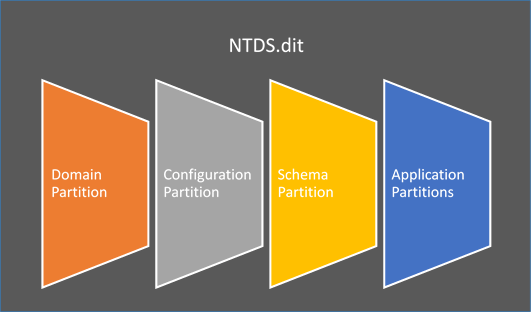Active Directory Partitions

Active directory database is divided into logical parts and each part is known as Naming context or AD partition. there are three naming contexts:- Schema, configuration and domain naming context.
Schema partition
The schema partition contains object and attribute definitions. In other words, the schema partition contains a list of definitions that define what objects and attributes for those objects can exist in the Active Directory. Schema information is enterprise in nature—all domain controllers in a tree or forest share a common schema and any schema modifications are replicated across the forest. Because the schema defines objects and attributes, an object that is created, along with it’s attributes, must conform to the definitions of the schema.
Configuration partition
The configuration partition contains information about the physical structure of the Active Directory, such as the sites and domains and where domain controllers reside in the enterprise. Configuration information is replicated to all domain controllers in the tree or forest.
Domain Partition
The domain partition contains information about all Active Directory objects that are specific to that domain, such as users and groups, OUs, and other resources. All domain partition information is completely replicated to all domain controllers within the domain. For global catalog servers in other domains, a read-only subset of the domain partition is replicated. This allows the global catalog server to know what is available in each domain so that other domain users can access resources, but changes to the domain partition can only be made from within the domain.
Application Partition
Windows Server 2003 introduces this partition. This holds information on many Services, like DNS, LDAP, etc. There are two logical sub-partitions inside your DNS if it is Active Directory Integrated:
DomainDNSZones: Contains all DNS information for a particular domain. This information replicates across all domain controllers in the local domain in AD Integrated DNS.
ForestDNSZones:- Stores all DNS information for the whole Forest in ForestDNSZones. The data replicates across all domain controllers in every domain in that forest in AD-Integrated DNS.
A unique Active Directory Partition called the Global Catalog Partition exists in addition to these partitions. This keeps track of all the data on the Global Catalogs (DCs) that are accessible within the forest. However, this is rarely utilized.
Configure your DNS zones’ replication scope to the new application directory partition.
Configure the replication scope of your Active Directory integrated DNS zones to that of the new application directory partition CustomDNSPartition using the DNS management tool Dnsmgmt.msc.
Follow these steps to accomplish this:
- Launch the DNS administration tool on one of the domain controllers managing the newly established application directory partition. Using DC-1 as an example, choose Start, click Run, enter dnsmgmt.msc, and then select OK.
- Expand DC-1, Forward Lookup Zones, and your Active Directory integrated DNS zone under DNS. Then click that zone.
- Click Properties on the Action menu to start.
- Select the Replication-related Change button.
- Click Click CustomDNSPartition.windowstechno.local in the Application directory partition name list to access all domain controllers listed in the scope of the following application directory partition.click OK.
- Click Apply, and then click OK.
Other domain controllers that host this specific custom application directory partition immediately take use of the new replication scope that you set up in step 5 once you configure the DNS zone replication scope to use it. You can refresh the DNS zone to manually enforce this change. Click Refresh from the context menu after right-clicking the DNS zone you wish to reload.
So, that’s all in this blog. I will meet you soon with some other stuff. Have a nice day !!!
Recommended content
RODC Installation Guide- Step by step guide to install read only domain controller
RODC Filtered Attribute Set
Installing and configuring a RODC in Windows Server-2012
How to find the GUID of Domain Controller
Understanding Group Policy Preferences
Group Policy Verification Tool GPOTool Exe
Group Policy Health Check on Specific Domain Controller
Netlogon Folder in Active Directory
Custom Attributes in Active Directory
Tombstone Lifetime of My Active Directory Forest
Computers AD Site From the Command Line
Active Directory Database Integrity
Disabling and Enabling the Outbound Replication
DFS Replication Service Stopped Replication
Strict Replication Consistency
The replication operation failed because of a schema mismatch between the servers involved
Troubleshooting ad replication error 8418 the replication operation failed because of a schema mismatch between the servers
Replication information in txt file
Repadmin Replsummary
Enabling the outbound replication
Guys please don’t forget to like and share the post.Also join our WindowsTechno Community and where you can post your queries/doubts and our experts will address them .
You can also share the feedback on below windows techno email id.
If you have any questions feel free to contact us on admin@windowstechno.com also follow us on facebook@windowstechno to get updates about new blog posts.
